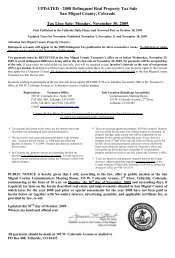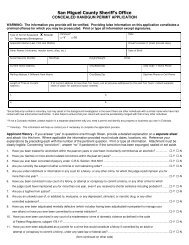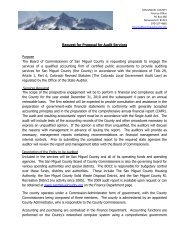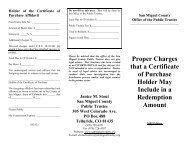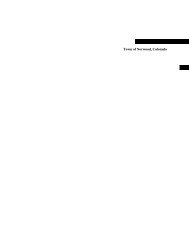colorado retail food establishment rules and ... - Boulder County
colorado retail food establishment rules and ... - Boulder County
colorado retail food establishment rules and ... - Boulder County
You also want an ePaper? Increase the reach of your titles
YUMPU automatically turns print PDFs into web optimized ePapers that Google loves.
monitoring activity could involve making visual inspections of the date marking<br />
system to monitor the sell, consume, or discard dates.<br />
4. How often is monitoring conducted?<br />
Monitoring can be performed on a continuous or intermittent basis. Continuous<br />
monitoring is always preferred when feasible as it provides the most complete<br />
information regarding the history of a product at a CCP. For example, the<br />
temperature <strong>and</strong> time for an institutional cook-chill operation can be recorded<br />
continuously on temperature recording charts.<br />
If intermittent monitoring is used, the frequency of monitoring should be<br />
conducted often enough to make sure that the critical limits are being met.<br />
5. Who conducts monitoring?<br />
Individuals directly associated with the operation (e.g., the person in charge of<br />
the <strong>establishment</strong>, chefs, <strong>and</strong> departmental supervisors) are often selected to<br />
monitor CCPs. They are usually in the best position to detect deviations <strong>and</strong> take<br />
corrective actions when necessary. These employees should be properly trained<br />
in the specific monitoring techniques <strong>and</strong> procedures used.<br />
E. Principle #5: Establish Corrective Actions<br />
1. What are corrective actions?<br />
Corrective actions are activities that are taken by a person whenever a critical<br />
limit is not met. Discarding <strong>food</strong> that may pose an unacceptable <strong>food</strong> safety risk<br />
to consumers is a corrective action. However, other corrective actions such as<br />
further cooking or reheating a product can be used provided <strong>food</strong> safety is not<br />
compromised. For example, a restaurant may be able to continue cooking<br />
hamburgers that have not reached an internal temperature of 155°F for 15<br />
seconds until the proper temperature is met. Clear instructions should be<br />
developed detailing who is responsible for performing the corrective actions, the<br />
procedures to be followed, <strong>and</strong> when.<br />
F. Principle #6: Establish Verification Procedures<br />
1. What is verification?<br />
Verification includes those activities, other than monitoring, that determine the<br />
validity of the HACCP plan <strong>and</strong> show that the system is operating according to<br />
the plan. Validation is a component of verification which focuses on collecting<br />
<strong>and</strong> evaluating scientific <strong>and</strong> technical information to determine if the HACCP<br />
system, when properly implemented, will effectively control the hazards. Clear<br />
instructions should be developed detailing who is responsible for conducting<br />
verification, the frequency of verification, <strong>and</strong> the procedures used.<br />
G - 18





